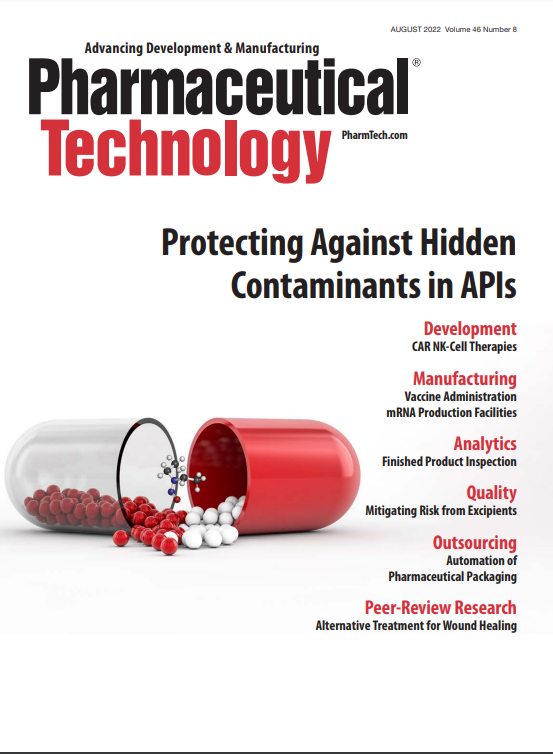Overcoming Engineering Challenges to Enable Commercial Scale mRNA Vaccine Manufacturing
This article provides an overview of solutions to address key challenges facing vaccine developers or CDMOs wishing to build their own commercial-scale mRNA production facilities.
ktsdesign - stock.adobe.com

Messenger RNA (mRNA) is an ingenious natural molecule involved in the creation of proteins, which are essential to biological processes. This same molecule is the basis of a new breed of mRNA vaccines, which were adapted in a matter of months to combat the SARS-CoV-2 pandemic (1).
Rapidly evolving mRNA technology will be key to addressing many unmet needs in vaccines and oncology, as well as supporting a more rapid, global response to future pandemic threats. The mRNA process offers the potential to rapidly produce more vaccine doses compared to conventional vaccines that use cell-culture based production routes, which are often more prone to failure (2).
Advances in mRNA, coupled with the need to ramp up production capacity to meet global demand (3), provide an opportunity to build flexible manufacturing capacity (4). However, larger-scale mRNA vaccine manufacturing poses challenges relating to facility design. As each project will have a unique set of requirements, it is important for solutions providers to address each consideration.
New mRNA good manufacturing practice (GMP) facility design must comply with strict regulatory and sustainability codes of practice, which vary globally. When it comes to delivering such projects, teams with expertise across a wide range of specialisms are needed to design, build, and operate this new class of therapeutics facility.
Manufacturing process
Production of mRNA-based vaccines differ from the approach used in conventional protein or viral vector-based vaccines as they are produced in cell-free systems. mRNA manufacturing involves the production of a DNA template, typically using linearized plasmids, followed by an in vitro transcription (IVT) enzymatic capping reaction, which produces the mRNA (See Figure 1).
Figure courtesy of the authors.

Following purification using chromatography techniques, the mRNA drug substance is encapsulated with a selection of nanolipids to form lipid nanoparticles (LNP), before further purification and buffer exchange using chromatography coupled with tangential flow filtration (TFF) to make the bulk drug product (BDP) (5) (See Figure 2).
Figure courtesy of the authors.

Low-temperature storage is needed until such time the BDP can be formulated, sterile filtered, filled or lyophilized in vials, labeled, and packed to make the vaccine. At present, multidose vials plus diluents comprise the pandemic vaccine product, but this is likely to change in the future (6).
The different process needs necessitate different facility design requirements. Examples are given in Table I.
Figure courtesy of the authors.

From a manufacturing perspective, mRNA’s potential lies in the capability of smaller-scale facilities to produce clinical trial materials as well as larger volumes of patient doses with the same equipment. The latter can be achieved via more intensive production schedules, or semi-continuous processing techniques.
Challenges and solutions
As a rapidly evolving field using disruptive approaches and technology, mRNA requires a reset in terms of the thinking around facility design. In contrast to the conventional approach, each mRNA project needs solutions providers to provide a ‘bottom up’ strategy, which should emanate from teams on the ground who have the necessary insight into the specific design, equipment, and materials handling considerations.
Biopharma companies should provide their best forecasting estimates for future capacity, number of products, and various formats that mRNA vaccines can be formulated into (e.g., liquid vs. lyophilized, multi-dose vs. single dose vials, transdermal patches, or inhalants).
Where mRNA vaccines currently fall short versus their cell culture-based product competitors is their dependency on steady supplies from others of costly and scarce starting materials (plasmid DNA, enzymes, nanolipids), plus the need for lower temperature storage of intermediates and products.
The latter point provides a geographic constraint for manufacturing and distribution sites. Both have contributed to a higher cost of
goods, which may limit market penetration during non-pandemic times and affect the facility’s operational and environmental sustainability.
In the absence of such a capacity estimate, mRNA projects could be restricted when it comes to scale, and manufacturers may also face limitations in relation to handling and containment measures for the raw materials used to produce mRNA.
While each project has a unique set of manufacturing and facility design challenges, the key challenges facing mRNA facility projects are scalability, use of flammable materials, and equipment and manufacturing support.
Process scale. Process scalability provides the potential to manufacture product in greater volumes. However, scaling out an mRNA process requires careful considerations and can introduce specific design requirements, which mean that it may not be possible to renovate a brownfield site or an existing facility.
The mRNA process can produce more doses than conventional biologics projects, so best practice involves estimating in advance the number of doses per batch that a project or facility will manufacture, establishing how many doses are required in what timeframe, and to evaluate the use of continuous processing strategies. This process will act as the starting point to guide each mRNA project and will determine the parameters for the design of a commercial facility.
To address this challenge, prefabricated modular facilities offer a solution for phased capacity expansion/scale out, while reducing interruption to existing operations.
Use of flammable materials. The use of significant quantities of flammable materials that are central to the mRNA production process requires tailored containment, handling, and disposal measures. These measures vary from project to project and effectively necessitate solutions providers to deliver one-off, bespoke solutions. Wider regulatory and sustainability issues also need to be considered.
Increasing production capacity may necessitate the facility to cater for higher hazardous area category (e.g., H-Occupancy) design features, such as specialized building construction and potential blast zones. These are typically undesirable as they adds to the cost and complexity to the project, especially if the project is a retrofit.
Once the scale of operations is defined, it is necessary to determine flammable quantities and assess whether there is a need for hazardous area compliant construction. It is recommended to assess if the process can be scaled back or run differently (more batches per year) to avoid this specialized aspect by operating below the relevant maximum allowable quantities (MAQs).
Use of semi-continuous processing strategies can minimize solvent use. Such an assessment should cover:
- Quantification of flammable material use for production steps, including buffer preparation and LNP storage
- Equipment and facility cleaning strategies that contribute to the facility flammable materials inventory
- Impact of HVAC design to avoid hazardous atmospheres (e.g., full fresh air), use of local exhaust ventilation (LEV) or fume hoods
- Solvent distribution methods (e.g., closed solvent delivery and waste removal systems)
- Location of solvent bulk storage outside of the processing area/facility, and piping in what is necessary plus removing spent solvent in a timely manner (e.g., piped transfer to a waste tank for removal by a specialist contractor).
Equipment and manufacturing support. Currently, there is limited commercial offering of dedicated, single-use, and/or explosion-proof equipment both for mRNA purification and LNP assembly at commercial scales (7).
Prompt equipment specification and procurement is needed to fix the facility design and ensure that their lead times are not on the critical path to plant start-up. At present, the process cannot be fully single-use, so thought needs to be put into the cleaning and sterilization processes, plus the analytical support infrastructure needed for reusable product-contact surfaces.
Therefore, it is recommended that for each mRNA project, consideration is given to the following aspects to determine the link between the equipment available and the facility design:
- Need for custom/proprietary equipment
- Independent production rooms with “through-wall” buffer transfer through iris ports in from logistics corridor (Buffer Prep/Hold)
- Room electrical classification needs versus process step
- Equipment selection versus electrical and fire code requirements
- Benefits and limitations of implementing single-use technologies, given that the process will be hybrid (with stainless steel).
Operational capacity will be mainly dictated by the availability of a skilled workforce for GMP manufacturing. Thought should be given to staff welfare facilities, which are key to retain skilled workers. Onsite canteens, adequate spaces for parking, lockers, and shift handover meetings need to be considered as well as the manufacturing suites.
From an operational perspective, process and facility design should consider continuous processing and implementation of process analytical technologies (PAT) to automate selected process steps (8). Low-temperature storage capacity should be included to allow for processing breaks (e.g., freezing of intermediates) to enable day-shift production.
Finally, the limited capacity for outsourcing of supporting functions, such as facility environmental monitoring or product sterility testing, should be considered during concept design. Just because the process is cell-free, the analytical in-process testing and release methods needed may not be. Inclusion of fully-segregated microbiological testing laboratory suites in the scope of the project should be considered if outsourcing is not an option. Basing designs on the use of recent advances in microbiological testing such as enzymatic indicators and rapid sterility testing can reduce the footprint of these labs (9, 10). An example of an LNP manufacturing area is shown in Figure 3.
Figure courtesy of the authors.

Conclusion
Linking process engineering knowledge to facility design is critical for compliant and competitive manufacturing in the life sciences sectors.
Novel mRNA-based therapeutics are on the cusp of transforming product and project delivery and has the potential to revolutionize modern medicine. By overcoming challenges related to manufacturing and facility design, solutions providers can play an important role in helping mRNA to face down future pandemics and, more broadly, make these life-changing medicines accessible to a greater number of patients, faster.
References
1. Coalition for Epidemic Preparedness Innovations (CEPI), “How Rapid-Response Vaccine Technology can Combat Disease X,” cepi.net, Nov. 29, 2021.
2. Z. Kis, et al., npj Vaccines online, DOI: 10.1038/s41541-022-00447-3 (March 2, 2022).
3. Pharmaceutical Technology Editors, “Moderna and Thermo Fisher Scientific Form Long-Term Strategic Manufacturing Collaboration,” Pharmtech.com, Feb. 23, 2022.
4. Pharmaceutical Technology Editors,”BioNTech Plans to Build Modular mRNA Manufacturing Facilities in Africa,” PharmTech.com, Feb. 21, 2022.
5. S.S. Rosa, et al. PMC online, DOI: 10.1016/j.vaccine.2021.03.038 (March 24, 2021.)
6. N. Peyraudab, et al., Vaccine 37 (32) 4427-4434 (2019).
7. Pharmaceutical Technology Editors, “Cytiva Provides Arranta Bio with Single-Use Manufacturing Platform for mRNA Products,” PharmTech.com, Feb. 1, 2022.
8. A. Ouranidis, et al. Pharmaceutics online, DOI: 10.3390/pharmaceutics13091371 (Aug. 31, 2021).
9. Protak Scientific, “Evaluation of Novel Process Indicators for Rapid Monitoring of Hydrogen Peroxide Decontamination Processes,” Whitepaper, May 2017.
10. BioMérieux, “Rapid Microbial Detection & Sterility Testing,” www.biomerieux-asean.com, accessed Jul. 21, 2022.
About the authors
Julie Vickers is a subject matter expert in Process Engineering, and Peter Cramer is a subject matter expert in Process Architecture at Jacobs. Ranna Eardley-Patel is a sustainable manufacturing lead at CEPI. Oliver Excell is an implementation expert at PA Consulting. Excell provided strategic review and input.
Article details
Pharmaceutical Technology
Vol. 46, No. 8
August 2022
Pages: 31-34
Citation
When referring to this article, please cite it as J. Vickers, et al., “Overcoming Engineering Challenges to Enable Commercial Scale mRNA Vaccine Manufacturing,” Pharmaceutical Technology 46 (8) 2022.

Drug Solutions Podcast: A Closer Look at mRNA in Oncology and Vaccines
April 30th 2024In this episode fo the Drug Solutions Podcast, etherna’s vice-president of Technology and Innovation, Stefaan De Koker, discusses the merits and challenges of using mRNA as the foundation for therapeutics in oncology as well as for vaccines.